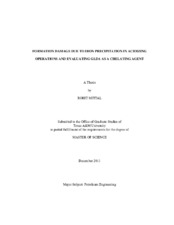| dc.description.abstract | Iron control during acidizing plays a key role in the success of matrix treatment. Ferric ion precipitates in the formation once the acid is spent and the pH exceeds 1-2. Precipitation of iron (III) within the formation can cause formation damage. Chelating agents such as EDTA and NTA are usually added to acids to minimize iron precipitation. Drawbacks of these chelating agents include limited solubility in strong acids and poor environmental profile. Hydroxy EDTA was introduced because of its higher solubility in 15 wt% HCl. However, its solubility in 28 wt% HCl is low and it is not readily biodegradable.
In this study we studied the formation damage caused by iron precipitation in acidizing operations and tested the chelate L-glutamic acid, N,N-diacetic acid (GLDA). This chelant is soluble in higher concentrations of HCl. It is readily biodegradable, and is an effective iron control agent. A study was conducted to study the concentration of iron at different pHs ranging from 1-4 without the presence of any chelating agent at room temperature. A similar study was conducted in the presence of a chelating agent. To simulate field conditions, coreflood tests were conducted on Indiana Limestone, Austin Chalk and Pink Desert. Tests were conducted with and without the chelant. Samples of core effluent were collected and iron and calcium concentrations were measured using atomic absorption spectroscopy (AA). The cores were scanned using X-ray before and after acid injection.
Results indicated that precipitation of iron can cause serious reduction in core permeability. The chelate was found to be very effective in chelating iron upto 300 degrees F. No permeability reduction was noted when GLDA was added to the acid. Material balance calculations show that significant amount of the iron that was added to the injected acid was produced when GLDA was used. This chelant is effective, environmentally friendly and can used up to 300 degrees F. | en |


